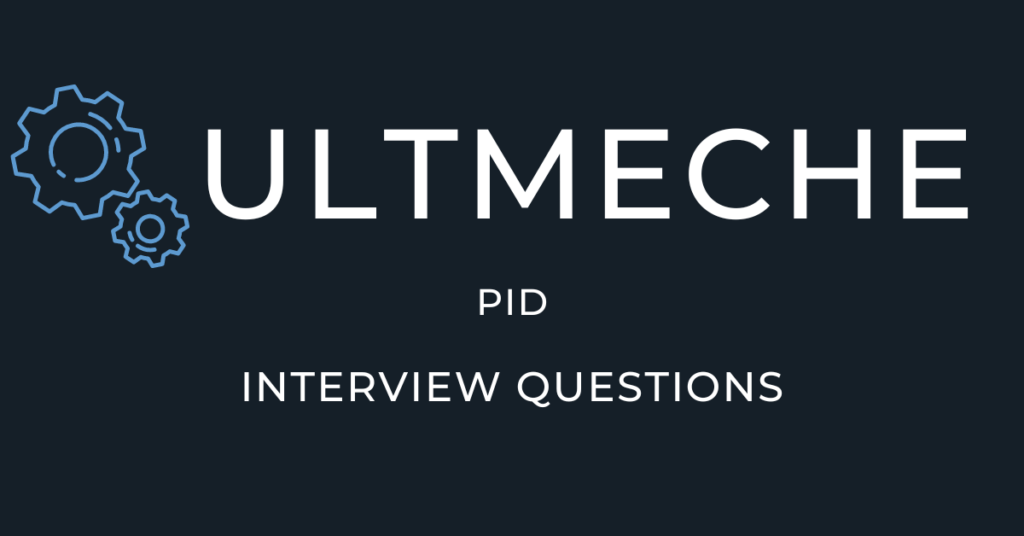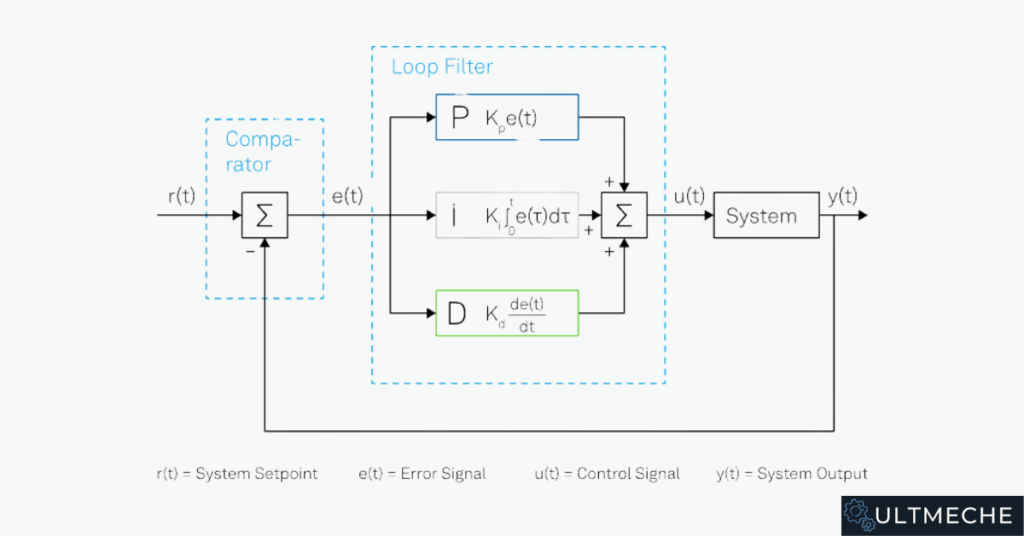Don’t understand basic PID interview questions?
You won’t get the job.
Knowing basic PID fundamentals is necessary for both for a job interview and for general knowledge. As any engineer working with control systems, you will need to demonstrate competence in both.
You will not provide value if you don’t understand the concepts of basic PID interview questions.
Engineering classes go very in depth, but in reality you only need to know the basics in your control systems classes.

May 21, 2024 by Kazu Fujimoto
The following questions are basic concepts that you will go over in a control systems class class.
Make sure you know these questions both so that you are ready for an interview and you also will need to know these terms if you want to be a good control systems engineer.
Book a technical mock interview with Kazu to 10X chances of landing the engineering job.
What is a PID?
A PID is a Proportional-Integral-Derivative controller. It is a mechanism used in control systems for industrial applications. Control systems are designed to set up and regulate processes by altering a signal set up between the desired set point, process variable, and feedback.
What is the proportional component in PID?
The proportional responds to the error and creates an output that is proportional relative to the error.
What is the integral component of PID?
The integral takes into account the cumulative error over time (integration) and generates an output based on the integral of the error.
What is the derivative component?
The derivative component takes into account the rate of change and generates an output based on the derivative of the error.
Can you draw me a PID controller diagram and label the following.
- P – Proportional
- I – Integral
- D – Derivative
- Loop Filter
- Comparator
- System
- Error Signal
- System Setponit
- Control Signal
- System Output

What is tuning and why is it important?
Tuning a PID controller consists of ensuring that the control system ensures stability and provides an accurate response. In testing, it consists of adjusting the proportional, integral, and derivative gain to achieve desired performance and accuracy.
What is a gain?
Gain is defied as the ratio of output to input. An example of a system is a servo system in which they use gains that correct errors between the target value – (pressure, load, position, velocity, torque) and the actual value. The three gains are known as proportional gain, integral gain, and derivative gain and they are used to mitigate errors in the system.
What are two basic types of control loops?
The two basic types of control loops are open and closed.
What is an open control loop?
In an open loop system, the controller does not use feedback to achieve the desired goal.
What is a closed control loop?
A closed loop system utilized feedback to determine if the output has achieved the desired goal in the control system.
How is a PID controller used in a temperature control system?
In a temperature control set up, the set point would be the desired temperature. The PID control system would measure the temperature, calculate the error from the established set point then adjust the output which would be something along the lines of heat input. This iterative process based on the algorithm of the PID would affect the performance and eventually result in minimizing error and reaching the set point.
How would temperature affect the performance of a PID controller?
Temperature change would change the input in a PID controller through a parameter such as heat input to adjust the output. This self correcting system would eventually result in minimal error and reaching the desired set point of a PID control system.
Tell me about your experience using data analysis and data acquisition.
My experience with data analysis and data acquisition has consisted of static testing for aircraft components. The instrumentation equipment consisted of LVDTs and Strain Gauges which were connected onto a Moog Pacific Instruments Data System. It was imperative to set up the system and perform tasks such as tuning to ensure that we had stability in the readings. Through the use of this equipment, we were able to test hardware that resulted in qualifying millions of dollars of parts for flight capability.
What software have you used regarding data analysis and data acquisition?
Software I’ve encountered regarding data analysis and data acquisition consists of those such as MATLAB, LabView, and Simulink.
Tell me about mechatronics automation systems or tests that you’ve performed or worked on
As a lead engineer, I was responsible for the delivery for the automation system used to manufacture semiconductor components. Through the evaluation of important KPIs such as number of non conformances and on time percentages, I noticed there was a big gap. I led an implementation effort to reduce the amount of non conformances and even increased the rate of doing so through machine learning and artificial intelligence technology. As a result, revenue goals were met for the quarter.
See: Mechatronics Interview Questions – Top 15
Can you tell me your thought process on how you would automate this experiment?
To automate any experiment, I would take this approach and thought process:
- Determine variables and operating conditions
- Understand project scope – schedule, cost, deliverables
- Implement technology such as AI and machine learning where possible for high volume repeatable tasks
- Set systems up and integrate PID system
- Evaluate and determine system response
- Iterate until desired system result is complete
Tell me about a time you used mechanical engineering principles such as machine design, thermodynamics, fluids, or beam deflection in a mechatronics system
See answers for different principles such as machine design, thermodynamics, fluid mechanics, or beam deflection and how they tie into PIDs below.
Machine Design
In a static test I was responsible for setting up, I had to design a mechanical reaction structure and load train to be used to apply load onto the test article. Many principles such as tolerance stack up, machine design, beam bending, were used to successfully design the structure and associated load train to test the system.
Thermodynamics
As a plant engineer, I was responsible for the set up of equipment for our power plant which consisted of pumps, turbines, compressors, heaters, boilers, and condensers. I was responsible for ensuring parameters such as volumetric flow rate, total dynamic head, cost, and schedule were accurate. A PID type controller system was integrated to maximize our thermodynamic cycle efficiency by monitoring work output through the turbine and work input through heat.
See: STAR Method for Interview Questions
Fluid Mechanics
As a flight test engineer, I was responsible for the design and testing of aircraft wings through airfoil testing in a wind tunnel. The goal of the wind tunnel testing was to determine and qualify that the performance, characteristics, and dimensions of the airfoil shape were optimally engineered. Principles such as Fluid Mechanics, Reynolds Number, Dimensionless Parameters, and compressible flow were taken into consideration in the design of this experiment.
See: Aerodynamics Interview Questions – Top 25
Beam Deflection
As the responsible test engineer and design engineer for static testing for aircraft hardware, I led and presented a Critical Design Review (CDR) to 20+ stakeholders. These stakeholders consisted of those such as team leads, senior analysts, program management, and even executives. Although the review went extremely well, one of the leads caught something in the design. As a result, this caused a change in the design which led to some schedule and cost impact. Had I analyzed the degrees of motion of the system more clearly, I would’ve been able to mitigate this risk.
We could’ve also chosen to continue with the design as is, but a simple beam deflection analysis of it shows binding in an unwanted area. This would be bad practice to continue with the design and manufacture, even if it meant saving on cost and schedule. Ultimately, we needed to execute with safety and correct design practices in mind.
How do you take into consideration factors such as safety in the design and operation of mechatronic systems that you’re working on?
Depending on the type of mechanical or mechatronic structure / component, I would assign specific safety factors to the equipment based on their loading conditions. I’d refer to industry or specifications to get the safety factors that I would need. I’d also take into account design ergonomics and ensure that the equipment is adequate for operations.
How would you determine repeatability in processes that incorporate a PID?
To determine repeatability, I would look at the inputs and outputs of the system. Would we be getting consistent results through a repeated number of tests? If there is consistency based upon a number of repeated operating conditions, then that would indicate repeatability in the process. I’d look at specific metrics such as raw data, tables, charts, graphs and look for correlations. I would also compare theoretical results vs. analysis results vs. actuals and determine whether or not we have consistency.
What are primary control issues you’d see with a flying wing?
Some parameters of a flight wing control system consist of those such as:
- Yaw
- Elevator
- Ailerons
- Roll
- Pitch
- Rudder
- Leading Edge
Flight control systems and aerodynamics will vary between aircraft and it may be an issue for a pilot to familiarize themselves with varyingg parameters.
What are aircraft’s modes of motion?
The three types of movement in an aircraft are pitch, yaw, and roll. Aircrafts will set things up such as control systems to ensure that these values will remain constant upon any disturbances.
Can you describe what it means for a system to be stable?
A stable system means that the input and output is under control. In a control system standpoint, a well tuned proportional controller will drive the system towards a desired set point. A poorly tuned proportional controller will drive hard changes in the system such that there will be a high number of oscillations around a set point. The system will be oscillating between max and min values, and as a result be unstable. A stable control system will have minimal variation between the desired set point and inputs.
What does it mean for an aircraft to be statically stable?
There are many types of aircraft stability types – static, dynamic, positive, neutral, negative, etc.
Ultimately, to be statically stable, an aircraft needs to return to it’s original characteristic upon being disturbed. A pilot will need to adjust the controls manually to do this or there needs to be some correction done by the control system to achieve stability.
Can you give me an example of how a PID system would be applicable in an actual engineering application?
Let’s take driving an automotive vehicle as an actual engineering application. You’re driving down the road, and trying to stay in the lane, so you’re constantly having to nudge the steering wheel to stay within the lane. If you move the steering wheel, you’ll need the right sensitivity such that the changes you make will keep you in the lane. Otherwise, if the system is not set right, you will end up steering off the road or crashing into something.
Closing Thoughts on PID Interview Questions
Control Systems is typically an advanced undergraduate or graduate engineering class. It will also set the foundation of your theoretical knowledge for your career.
There’s so much to cover from mechanical engineering, electrical engineering, and software engineering to achieve to cost competitive and economical solutions for applications such as Aerospace and Automotive design.
Use these basic PID interview questions as a guideline to prepare yourself.
Want to learn how to write a good control systems engineer resume and learn more about engineering?
Check out: Entry Level Mechanical Engineering Resume
Don’t forget to check out our career services as we provide services such as resumes, cover letters, interviews, and LinkedIn optimization for those specializing in engineering careers.
Book a technical mock interview with Kazu to 10X chances of landing the engineering job.
Our mock interviews break up behavioral and technical step by step and as a result will prepare you for challenging interviews.
PID Interview Questions Reddit References
About the author

Kazuyoshi Fujimoto, PE
Founder | Engineering Career Coach | Principal Mechanical Engineer
Kazu oversees all of ultmeche’s engineering services. He provides consulting such as resume reviews, rewrites, mock interviews, and all services career related. Additionally, Kazu performs consulting work regarding Oil & Gas, Automotive, and Aerospace & Defense. Kazu is licensed as a professional engineer in the state of California and has 9+ years of experience in Oil & Gas, Automotive, and Aerospace & Defense.
